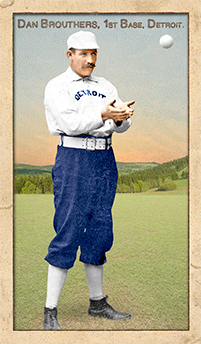
- Series: Beginnings: 1880's
- City: New York
- Team: Giants
- League: National League
- Hall: National Baseball Hall of Fame
Roger Connor (1857-1931) was the home run king of the 19th century, clouting 138 in his 18-year career. His record stood for 23 years after his retirement, until Babe Ruth surpassed him in 1921. Connor anchored first-base for five teams, winning pennants twice with the Giants. His flair for the dramatic was never more evident than when he struck the first-ever major league grand slam with his team down by three with two outs in the ninth. Born in Connecticut, Roger played for local clubs until joining the Troy Trojans in 1880. That NY hamlet witnessed five future Hall of Famers on their squad with Connor playing alongside Dan Brouthers, Buck Ewing, Tim Keefe and Mickey Welch. After moving to the Gothams, the 6’3” Connor inspired owner Jim Mutrie to proclaim the team “my giants!” and a new identity was born.
- Much more than a slugger, Connor won the NL batting title in 1885 and consistently hit .300+ while exhibiting remarkable speed for a big man (still fifth all-time in triples)
- Connor lived to see Ruth claim his HR title. It was thought at the time, however, that Connor had hit 131 HRS and Ruth's record was celebrated at 132. Writing for SABR in 1975, John tattersall discovered that Connor had actually hit 138 HRs.
- Jay Jaffe's JAWS system ranks Connor as the 5th greatest 1st baseman of all-time, just behind Cap Anson and just ahead of Jeff Bagwell
- Beloved by fans and the baseball press, he had a particularly strong advocate for the Hall in fellow legend, umpire Bill Klem
- Elected to Hall of Fame: 1976

- Series: Beginnings: 1880's
- City: St. Louis
- Team: Browns (AA)
- League: American Association
- Hall: National Baseball Hall of Fame
Charles Albert Comiskey (1859-1931) rose from decent first-baseman to become one of the foremost managers and owners of baseball’s early decades. “The Old Roman’s” leadership skills emerged with his first team, the newly-minted St. Louis Browns whom he piloted to four pennants. He would go on to compile an outstanding 840-541 record. His .608 winning percentage is third-highest behind Joe McCarthy and Jim Mutrie. “Commy” parlayed his ownership of the Western Association’s Dubuque Rabbits into a franchise in the American League which he helped found in 1901. He built the White Sox stadium in 1910 which would bear his name for the next 81 years and presided for the next decade over one of the most talented and troubled teams in history. While many dismiss the charge that it was Comiskey’s penurious ways that “drove” his 1919 squad to infamy, there is no doubt he was a cheapskate of the first order. He underpaid, over-promised and reneged with abandon, epitomizing the arrogance of the reserve-clause era.
- Charles is credited with revolutionizing play at first-base, innovating play off the bag
- Owned the Chicago White Sox from 1901-1931, winning two World Series
- Elected to Hall of Fame: 1939
- Series: Beginnings: 1880's
- City: Detroit
- Team: Wolverines
- League: National League
Dennis Joseph Brouthers (1858-1932) was one of the truly great hitters of the 19th century. Dan (pronounced BROOTHERS) played for ten teams over 19 seasons. He led the NL in OBP five times; SLG% seven times; H & 2B three times; Rs, HRs, & RBI twice. The 19-year old Brouthers vowed to quit the game when Johnny Quigley, a catcher for Harlem in 1877, died a month after a horrific home plate collision with Big Dan. He relented after the shock subsided & went on to the most prolific career of his era.
- One of only 29 to play in four decades
- .342 BA is 9th all-time; .423 OBP is 15th
- Elected to Hall of Fame: 1945

- Series: Beginnings: 1880's
- City: Chicago
- Team: Maroons
- League: Western Association
Charles Boyd is another of the Old Judge mystery men. He appears in the 1888 card series in three poses in the uniform of the Chicago Maroons of the Western Association. He is right-handed and identified as a first-baseman. Miller, Gonsowski and Masson, in their Old Judge compendium, relate a reference from the Feb 18, 1888 Sporting News reporting the signing of Charles, of Sheffield IL, by the Maroons. A March 31 article predicted this fleet-footed (“he can beat Billy Sunday”) slugger would join the club by April 15. We find no record of Boyd making the Maroons or any other minor league team. There is a cryptic reference to a “Boyd” on the roster of the Danville, IL Browns in 1888 but there is nothing else to identify that player.
- The Old Baseball Cards website lists the Boyd card as depicting “Jake” Boyd while the Goodwin editors have him as “Charles” with the Sporting News items as support
- As ever with these “ghosts” from the early decades of the game, Ars Longa welcomes any leads on identifying Mr. Boyd
- Series: Beginnings: 1880's
- City: Indianapolis
- Team: Hoosiers (NL)
- League: National League
Walter Bogart (Bogert?) is depicted on Old Judge cards identified as the first-baseman for the Indianapolis Hoosiers. There are four poses that suggest an infielder. The commentary in The Photographic Baseball Cards of Goodwin & Company (1886-1890) edited by Miller, Gonsowski and Masson indicate Bogart was invited to compete for the Hoosiers’ first-base job in 1888. They cite a Sporting News reference calling Bogart “an experiment in the league, at best.” Bogart did not make the roster. Dude Esterbrook and Jumbo Schoeneck were the team’s first-sackers that year. No other information about this aspiring big-leaguer is available.




